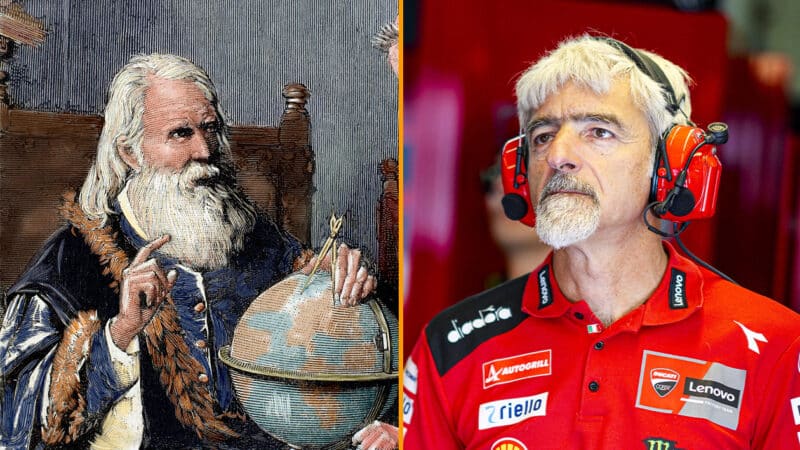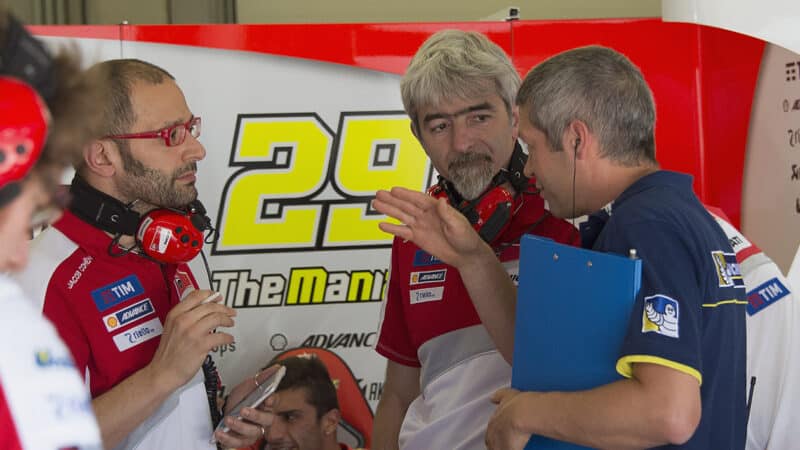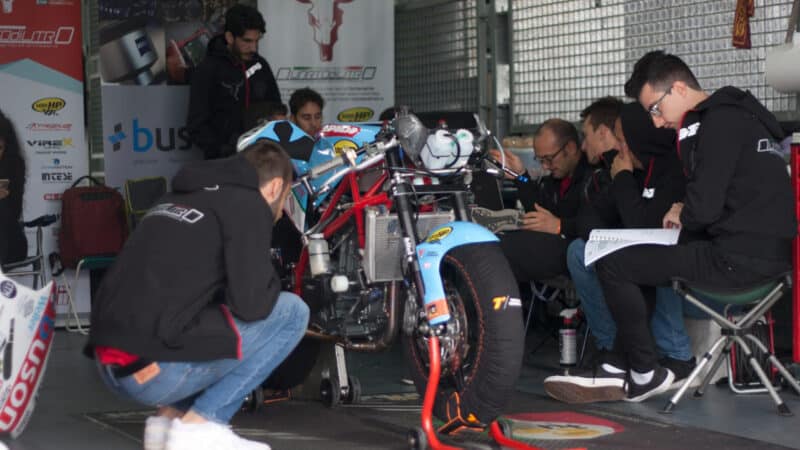How Italy’s MotoGP dominance goes back to Galileo and the Renaissance
Galileo studied planetary movements at Padua University. 300 years later, it taught Ducati MotoGP chief engineer Gigi Dall'Igna a more terrestrial form of motion. Why has northern Italy — once home to Renaissance revolutionaries — become a powerhouse of automotive knowledge?

Renaissance genius Galileo and Ducati genius Gigi Dall’Igna both studied at Padua university, one of the Italian seats of learning that power today’s MotoGP grid
Getty and Ducati
MotoGP’s five manufacturers – Aprilia, Ducati, Honda, KTM and Yamaha – all employ key engineering staff that were educated at a handful of universities in northern Italy.
How can this be? Why do Japanese and Austrian companies need Italian motorcycling brains?
The reason isn’t because Italian brands have come to dominate racing in recent years, because the reasons for that domination go much deeper and further back than recent history.
The universities and polytechnics of Bologna, Milan, Modena, Padua and Turin are the ancient seats of learning where scientists, philosophers and mathematicians like Galileo and Copernicus changed the world during the Renaissance and where Enzo Ferrari and Guglielmo Marconi helped forge the modern world during the 20th century.
Ducati’s chief engineer Gigi Dall’Igna (a big fan of Galileo) did his degree in mechanical engineering at Padua University (founded in 1222), where Galileo and Copernicus studied in the 16th and 17th centuries and taught us that the sun, not Earth, was the centre of our universe. The work of these Renaissance scholars was the start of mankind’s first scientific revolution.
Ducati’s chief vehicle dynamicist Riccardo Savin also studied at Padua, as did Aprilia race manager Paolo Bonora and Aprilia’s chief mathematician Elena De Cia, whose master’s thesis was the Optimization and parametrization of trajectories for racing motorcycles.
Yamaha’s new technical director Max Bartolini, formerly Ducati’s vehicle performance engineer, and Fabio Quartararo’s crew chief Diego Gubellini both studied at Bologna, the West’s oldest university (founded in 1088), where Ferrari, Marconi, the inventor of radio, and Dante, the author of Dante’s Inferno, laid the foundations of their genius.
Honda electronics engineers Filippo Tosi, another former Ducati employee, and Carlo Luzzi, who started out at Yamaha’s Milan-based World Superbike team, did their degrees at Milan university, as did Marco Nicotra, the Ducati aerodynamicist who followed Bartolini to Yamaha this year.

Padua university – established in 1222 – where Ducati’s Dall’Igna, Aprilia’s Bonora and Galileo studied
Padua University
KTM’s MotoGP performance manager Alby Giribuola, formerly with Ducati, went to the Polytechnic University of Turin, as did Aprilia chief engineer Romano Albesiano, who studied aeronautics (which may have something to do with the RS-GP’s superb aero). Turin was Italy’s first technical college, established in 1859, a few minutes away from Turin University, where Erasmus became one of the greatest thinkers of the Renaissance.
And Davide Barana – technical director of the factory Ducati team – went to Modena University, founded in 1175.
This phenomenon has its roots in the Renaissance but in fact goes back even further than that, to the Roman Empire.
Primarily to a Roman road called the Via Aemilia, which was built around 200BC and ran dead straight (of course) between Rimini and Piacenza, near Milan, to colonise the area and ultimately create Italy’s most economically important region. The Romans’ exceptional technical skills were the start of Italy’s engineering brilliance. Along the road they established towns, including Bologna and Modena. The universities followed a few centuries later.
The Via Aemilia became busy with workshops that built and maintained the carriages which carried goods and people along the road and beyond. When the internal combustion engine arrived at the turn of the last century these workshops naturally moved into making carriages powered by gasoline instead of horses.
“This is when we started the path from artisans to engineers,” says Fabrizio Dughiero, director of Padua University’s department of industrial engineering. “This is why Italy is so successful in this field.”
Thus the descendants of the earlier craftsmen of Via Aemilia – skilled in metalwork, coachwork and other skills revolving around wheels – were the workers who started building Ferraris in Modena.

Former Ducati vehicle performance engineer and now Yamaha’s new technical director Bartolini (left) studied at Bologna, where Enzo Ferrari also studied
Mirco Lazzari GP/Getty Images
Many other car and motorcycle marques and associated businesses were born before and after Ferrari, on or near the Via Aemilia (the A1 autostrada follows roughly the same route): Gilera in Arcore near Milan, Magnetti Marelli and Pirelli in Milan, Ducati, Lamborghini and Maserati in Bologna.
This is why the region is now known as Motor Valley.
All these companies needed skilled engineers, so the Motor Valley universities of Bologna, Milan and Modena, plus Padua (northeast of Bologna) and Turin (southwest of Milan) became a powerhouse of automotive knowledge: mechanical engineering, electronic engineering, material science, aerospace engineering, aerodynamics and mechatronics.
These are all the skills required to create a modern MotoGP bike. And this is why Honda, KTM and Yamaha keep hiring engineers educated at these universities.
“Italy has a history of making two- and four-wheel racing vehicles, starting with Ferrari,” explains Elena Bassoli, professor at the Motor Vehicle University of Emilia-Romagna and in the Enzo Ferrari engineer department at Modena and Reggio Emilia University. “More companies followed, which demanded a supply chain, so everything built into a positive cycle. Motors surround us, so Italian people get enthusiastic about racing and young people want to become students to study vehicle engineering.
Dughiero worked with Italy’s most famous motorcycle professor, Vittore Cossalter, who wrote several books and more than forty scientific papers about motorcycle dynamics. Cossalter [who died earlier this year] counted Dall’Igna among his many pupils at Padua University, which is only twenty miles from the Aprilia factory, where Dall’Igna started his career.
“Vittore was a polymath, like the polymaths of the Renaissance, who worked and had ideas in different fields, from art to engineering,” adds Dughiero. “Vittore was a motorcycle academic recognised around the world, including Japan, but he wasn’t only an academic, he also loved applying his theories to the real world. This is one reason why Aprilia has been so successful in racing.”

Padua university’s Quarto di Litro student association designs and builds its own racing motorcycle each year
Quarto di Litro
Padua has a group of students who work together designing and engineering their own racing motorcycle. The group, which worked with Cossalter, calls itself Quarto di Litro (quarter of a litre – 250cc).
“Every year more than fifty students prepare a racing motorcycle, with special features,” adds Dughiero. “They work in all areas – the engine, vehicle dynamics, aerodynamics, electronics and also marketing and business.”
Bassoli, whose area of speciality is 3D printing (also known as additive manufacturing), also relates to the Renaissance.
“Michelangelo said that the sculptures he produced were already in the marble – his role was only to remove the unnecessary parts, so the role of the artist was to free the shape that was already there. Thus sculpture is an early and slow method of milling.”
The universities where Bassoli and Dughiero teach have close relationships with both Aprilia and Ducati. They work with the two companies on research and help them recruit their best students and graduates.
“In fact these companies need more engineers than we can train each year,” adds Bassoli, who is also working hard at improving the gender balance in engineering, by encouraging more women to enter this world. “So we are working to fix this bottleneck.”
And of course their eyes are also on the future.
“We sit together [with the manufacturers] to work out what knowledge will be required in ten years’ time,” Bassoli continues. “Then together we decide the curriculums and plan the courses.”
What skills will be needed in MotoGP 2034? That’s for another time…
